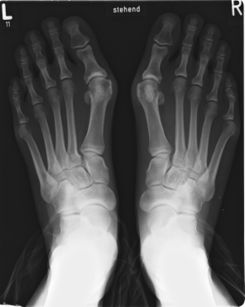Bunion
| Bunion | |
|---|---|
| Classification and external resources | |
| ICD-10 | M20.1 |
| ICD-9 | 727.1 |
| DiseasesDB | 5604 |
| eMedicine | orthoped/467 |
| MeSH | D006215 |

A bunion is a structural anomaly of the bones and the joint between the foot and big toe, and it may be painful.[1] A bunion is an enlargement of bone or tissue around the joint at the base of the big toe (metatarsophalangeal joint).The big toe may turn in toward the second toe (angulation), and the tissues surrounding the joint may be swollen and tender.
Today the term usually is used to refer to the pathological bump on the side of the great toe joint. The bump is the swollen bursal sac and/or an osseous (bony) anomaly on the mesophalangeal joint (where the first metatarsal bone and hallux meet).
Contents |
Definition
The term "hallux valgus" or "hallux abducto-valgus" are the most commonly-used medical terms associated with a bunion anomaly, where "hallux" refers to the great toe, "valgus" refers to the abnormal angulation of the great toe commonly associated with bunion anomalies, and "abductus/-o" refers to the abnormal drifting or inward leaning of the great toe towards the second toe, which is also commonly associated with bunions.
Signs and symptoms
The McMaster kinesiology of symptoms of bunions include irritated skin around the bunion, pain when walking, joint redness and pain, and possible shift of the big toe toward the other toes. Blisters may form more easily around the site of the bunion as well.
Having bunions can also make it harder to find shoes that fit properly; bunions may force a person to have to buy a larger size shoe to accommodate the width the bunion creates. Wearing high heels also becomes more of a problem for those with bunions as the heel puts pressure on the toes, which may be irritating to most people in general, but even more so in those with bunions.
Pathophysiology
Bunions are mostly genetic and consist of certain tendons, ligaments, and supportive structures of the first metatarsal that are positioned differently. This bio-mechanical anomaly may be caused by a variety of conditions intrinsic to the structure of the foot – such as flat feet, excessive flexibility of ligaments, abnormal bone structure, and certain neurological conditions. These factors are often considered genetic. Although some experts are convinced that poor fitting footwear is the main cause of bunion formation,[2] other sources concede only that footwear exacerbates the problem caused by the original genetic structure.[3]
Bunions are commonly associated with a deviated position of the big toe toward the second toe, and the deviation in the angle between the first and second metatarsal bones of the foot. The small sesamoid bones found beneath the first metatarsal (which help the flexor tendon bend the big toe downwards) may also become deviated over time as the first metatarsal bone drifts away from its normal position. Arthritis of the big toe joint, diminished and/or altered range of motion, and discomfort with pressure applied to the bump or with motion of the joint, may all accompany bunion development.
Treatment
Bunions may be treated conservatively with changes in shoe gear, different orthotics (accommodative padding and shielding), rest, ice, and medications. These sorts of treatments address symptoms more than they correct the actual deformity. Surgery, by an orthopeadic surgeon or a podiatrist, may be necessary if discomfort is severe enough or when correction of the deformity is desired.
Orthotics
Orthotics are splints, regulators while conservative measures include various footwear like gelled toe spacers, bunion / toes separators, bunion regulators, bunion splints, and bunion cushions.
Surgery
Procedures are designed and chosen to correct a variety of pathologies that may be associated with the bunion. For instance, procedures may address some combination of:
- removing the abnormal bony enlargement of the first metatarsal,
- realigning the first metatarsal bone relative to the adjacent metatarsal bone,
- straightening the great toe relative to the first metatarsal and adjacent toes,
- realigning the cartilagenous surfaces of the great toe joint,
- addressing arthritic changes associated with the great toe joint,
- repositioning the sesamoid bones beneath the first metatarsal bone,
- shortening, lengthening, raising, or lowering the first metatarsal bone, and
- correcting any abnormal bowing or misalignment within the great toe.
The age, health, lifestyle, and activity level of the patient may also play a role in the choice of procedure.
Bunion surgery can be performed under local, spinal, or general anesthetic. The trend has moved strongly toward using the less invasive local anesthesia over the years. A patient can expect a 6- to 8-week recovery period during which crutches are usually required for aid in mobility. It is much less common today as newer, more stable procedures and better forms of fixation (stabilizing the bone with screws and other hardware) are used.
See also
References
- ↑ American College of Foot and Ankle Surgeons. "Bunions". http://www.footphysicians.com/footankleinfo/bunions.htm. Retrieved 2008-03-05.
- ↑ http://orthopedics.about.com/cs/toeproblems/a/bunions.htm
- ↑ http://www.footphysicians.com/footankleinfo/bunions.htm
External links
- Textbook of Hallux Valgus and Forefoot Surgery, complete text online in PDF files
|
|||||||||||||||||||||||